#LearnDart
Explore tagged Tumblr posts
Text
15 Libraries You Should Know if You Build with Dart
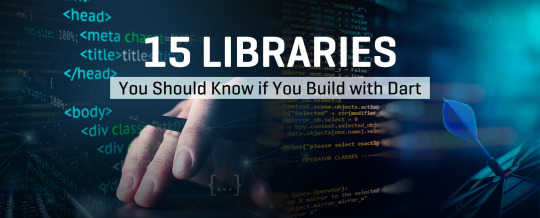
Introduction
Front-end developers popularly use Dart language for cross-platform development as Dart makes it faster. Besides having beneficial core features like Ahead-of-Time (AOT) and Just-in-Time (JIT) for enhancing development speed and UI-focused performance, Dart has a rich library that benefits both developers and business owners.
These libraries present appropriate tools and utilities that help developers streamline basic tasks like state management, HTTP requests, or file handling. In this blog, I will introduce 15 essential Dart libraries that every developer should know to make their development experience more comprehensive, faster, and convenient.
Build Using Dart Libraries
A library in Dart is a reusable component of code providing specific functionality or features. Libraries allow modularizing the code, making it easier to reuse, maintain, and test. Libraries can provide utilities for,
Making HTTP requests,
Managing states of the application,
Simplifying authorization,
Assisting with background tasks like fetching data,
Helping with integration tests,
Working with databases, and many others.
A developer can either build their library or use a third-party one available on such platforms as ‘pub.dev’. By importing a library into a Dart project, one can extend its functionality without developing it from scratch.
15 Libraries to look for when building with Dart
1. HTTP
The HTTP package is a lightweight and simple library; it is designed for making HTTP requests easy with Dart. The package allows making all general CRUD (Creare, Read, Update, Delete) operations such as GET, POST, PUT, and DELETE. Moreover, its syntax is as simple as possible. For instance, the library allows interpreting precisely and concisely with REST data, as well as handling responses. The HTTP package is an adequate choice for small projects seeking uncomplicated and concise network interaction.

Explanation: This snippet makes a GET request to fetch a list of posts and prints the response body to the console.
2. Dio
Dio is a powerful HTTP client for Dart that allows developers to easily send network requests and manage responses. It is written with best OOP practices and contains a clear and cohesive API for handling HTTP requests. Dio offers such features as interceptors, cancellation, and retrying but what’s more important it simplifies creating requests on JSON formats and forms. If your application works with a server, then this library will save time for you.

Explanation: This shows how Dio makes network requests and handles responses, similar to HTTP, but with more power and flexibility.
3. Provider
For building Flutter apps, I believe that Provider is mainly used because it is one of the most frequently used libraries for state management. By utilizing Provider, developers can take care of the state across different sections of the application. As such, it is a useful tool for separating a UI from business logic and keeping the code more concise and neat. In addition, this library is highly scalable, which is useful for maintaining and operating complex applications with nested widgets relying on shared data.
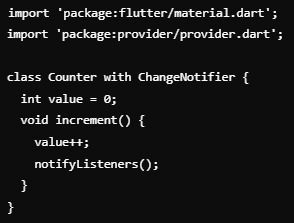
Explanation: This shows how Provider helps manage the state in a Flutter app. The Counter class can notify the UI when its value changes, ensuring reactive updates.
4. Hive
Hive is a high-performance, lightweight, and fast key-value database designed for Dart applications. It is very efficient and provides strong encryption capacities allowing for very secure data storing and management. Thus, the key element for utilizing this database is working with significant tokens, like user identification of credentials. The main advantage of Hive is that the database does not require significant installations or configuration, which means it is very easy to integrate with an application and then delete if not needed.
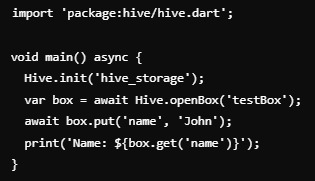
Explanation: This example demonstrates storing and retrieving a key-value pair using Hive for local persistence.
5. GetX
GetX is a very high-performance library not just for state management, but also for navigation and dependency injection in a Flutter app. Its no-boilerplate and high-performance features make it one of the most-used libraries currently. GetX is especially useful in apps requiring multiple layers of UI states and complicated navigation. It is also reactive, meaning it can handle all the service calls and back-end connectivity without any additional support.
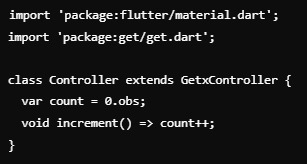
Explanation: GetX allows reactive state management with simple syntax. The count variable automatically updates the UI when changed.
6. Bloc
The Bloc library is an implementation of the Business Logic Component pattern and provides an ordered and structured way of managing the state in Flutter apps. It separates the business logic from the UI, which means your codebase remains clean, modular, and testable. Since the Bloc library uses Streams, it is best suited for applications that need a real-time update of data or have certain complex user flows to be implemented. Bloc is recommended to be used in large applications, where being predictable and scalable is critical.

Explanation: This code shows how the Bloc separates logic from the UI. The CounterCubit manages the state, emitting new values when the counter is incremented.
7. Intl
Intl is a powerful library for internationalization and localization in Dart apps. It provides all the necessary tools for formatting dates, numbers, and currencies depending on the locale, which becomes indispensable when developing global applications. The necessity to manage localized messages at some point is more likely. Along with more than 400 supported locales, the library also helps to customize your app according to users’ time zones, oriental currency format, and even the choice of language.
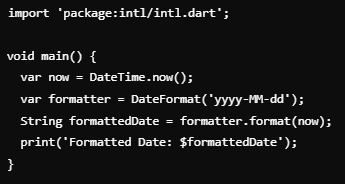
Explanation: This shows how Intl formats a DateTime object into a specific string format, making it adaptable to different locales.
8. Equatable
Equatable is a simplified way of comparing objects in Dart by overriding “==” and “hashCode” methods automatically. Otherwise, in Dart classes, you would manually implement these methods to create comparison operations between object instances. Since it helps to avoid repetition, Equatable is convenient to use with state management solutions, where object comparisons occur regularly. Particularly it is beneficial when dealing with complex objects having numerous fields that need to be compared.

Explanation: This example shows how Equatable allows easy comparison between objects, without manually overriding equality methods.
9. Json_Serializable
Working with APIs that return JSON is a common way of getting data. However, manually converting this data into Dart objects is not the most efficient process. The JsonSerializable used with annotations is a way to automatically generate code for serializing and deserializing. In other words, you can easily convert the data from Dart objects to JSON and vice-versa with little to no work. This is particularly useful for big applications where working with external APIs is done regularly. It ensures that the process is fully automated and no errors are made in the conversion.
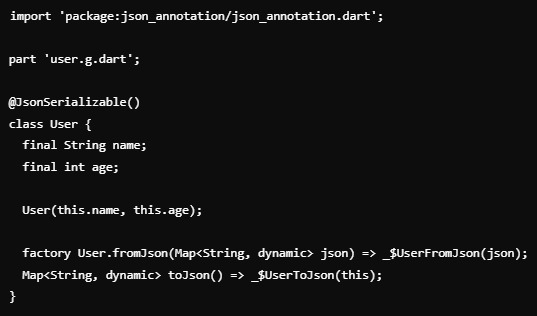
Explanation: Here, JsonSerializable is used to generate code that converts a User class from and to JSON format, making API integration easier.
10. Freezed
Freezed is a code generation library designed for the immutable data classes in Dart. It allows one to create classes that are as simple as they are safe to use, with several features corresponding to union types and pattern matching included. The library can also be seen as a good means of dealing with other libraries like Bloc and Provider, integrating itself well. If you face problems of state management with complex state transitions or simply need immutable objects with the minimum boilerplate, Freeze can be an excellent way out.
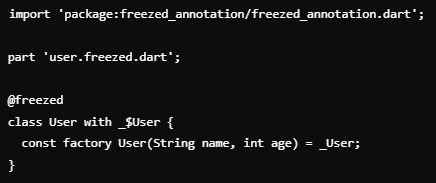
Explanation: This shows how Freezed helps create immutable classes and reduces repetitive code when defining simple data models.
11. Path
The path is an essential cross-platform library that facilitates the process of working with file paths in Dart. The library is designed to work consistently across Windows and Unix-based platforms. Since various applications need file I/O, it is particularly crucial to address this issue, as Windows and Unix-like systems depend on different file path conventions. Path facilitates operations with file and directory paths– joining and splitting paths, as well as normalizing a path to its canonical form.
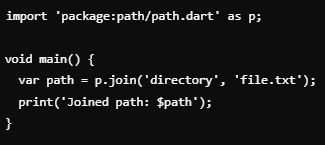
Explanation: This example demonstrates joining file paths in a cross-platform way, ensuring compatibility with different operating systems.
12. Built Value
Built Value is a convenient library for Dart that can be utilized for developing immutable data models. As this tool forces immutability, structures cannot be changed, making it suitable for applications that work with complex data models or API responses. By using Built Value, you can make sure that objects will be unalterable and have types, which contributes to better and more reliable code. In addition, the library supports code generation that reduces the amount of boilerplate material to be used for creating data classes.
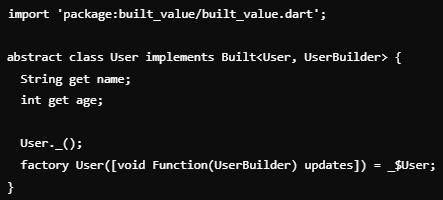
Explanation: Built Value enforces immutability and provides structured ways to create and manipulate objects in a type-safe manner.
13. Fluro
Fluro is a routing or navigator library developed for Flutter which is high-performance and makes navigation to different pages or screens in your app much easier with dynamic route handling, route parameters, and deep linking. It was developed primarily to help in navigation in larger applications with some more complex navigational requirements where you want to have complete control over how routes are defined and handled. This makes it the perfect choice for apps that require custom navigation solutions and deep integration with web-based URLs.

Explanation: Fluro helps handle navigation and routing between different pages, especially useful for complex navigation scenarios.
14. RxDart
RxDart is a perfect library for building apps that depend on interactive or real-time updates. It extends Dart’s standard Stream API with reactive programming principles. This Dart library applies a broad series of operators to work with data streams asynchronously and is perfect for managing complex event-based processes. Both subjects and observables with simple operators, such as map, filter, and merge, are supported. This makes RxDart an excellent tool in different cases. For example, if a developer is writing a chat or dashboard app with real-time updates, it will be the perfect solution.
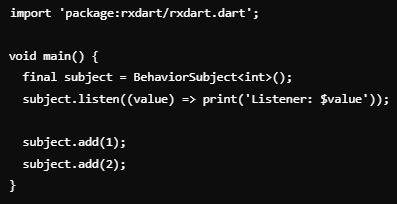
Explanation: RxDart makes handling asynchronous data streams easier. The Behavior Subject emits values that are automatically listened to by subscribers.
15. Firebase
If you need to add any backend service to your app in Flutter, your first choice is likely to be Firebase. It covers all your backend needs- authentication, real-time databases, cloud storage, and push notifications. Using Firebase with Dart is very simple since there is a set of libraries like firebase_auth and cloud_firestore. As a result, you can seamlessly add cloud-based features to your app without writing a single line of backend code. No matter whether you want to build a chat, e-commerce, or social networking app, Firebase has everything you need.
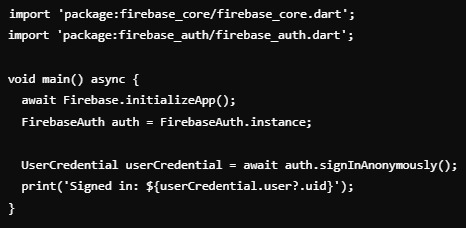
Explanation: This example demonstrates how to initialize Firebase and use its authentication service to sign in a user anonymously.
FAQs
1. Which Dart libraries are used in web development?
A few Dart libraries for building web apps are HTTP, json_serializable, intl, firebase, and many others. These libraries are used for fetching data from APIs, converting between Dart objects and JSON, formatting for dates, and currencies handling language translation, and securing authentication respectively.
2. Which Dart libraries are used in mobile app development?
The following Dart libraries are used in mobile app development among many others - GetX, Firebase, Hive, HTTP, and Provider. The provider helps in managing the state of the mobile applications, GetX simplifies navigation within apps built on Flutter, HTTP helps you manage network requests, Hive locally stores high-value objects and Firebase assists with user authentication and real-time updates.
3. What is the Dio library in Dart?
Dio is a popular HTTP client library in Dart. It is primarily used for simplifying networking requests like performing CRUD operations (Create, Read, Update, and Delete). Dio's core functionalities like interceptors, error handling, timeouts, file uploading, forming data, etc make it highly preferred in Dart projects.
Conclusion
There are plenty of libraries in the Dart ecosystem to create everything from mobile to web to desktop applications. If you are building user interfaces, managing the state of your application, or working with HTTP requests or files, these libraries described in this blog will help you speed up the development process. Using these libraries will allow you to concentrate on creating new features without reinventing the wheel.
#DartLibraries#DartProgramming#FlutterDevelopment#DartTools#DartCommunity#OpenSource#ProgrammingTips#DeveloperResources#DartLanguage#LearnDart
0 notes